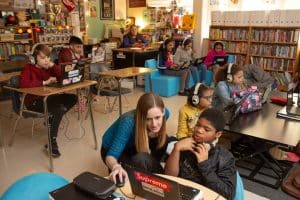New USED Educational Technology Report Shares Strategies for Using Edtech to Advance Student-Centered Learning
Education Domain Blog

The U.S. Department of Education’s Office of Educational Technology recently released the 2024 National Educational Technology Plan (NETP): A Call to Action for Closing the Digital Access, Design and Use Divides. The first version of NETP was released in response to the America’s Schools Act of 1994 and was most recently updated in 2016. Departing from the traditional approach to the report, this version addresses not only the baseline issue of ensuring equal access to technology, but also how to support all educators and students in using technology to effectively enhance student learning. The plan is organized around three challenges:
- Digital Use Divide. The section provides recommendations for how to support the effective use of technology. Some schools and classrooms use technology as an active tool in the learning process by researching topics, creating presentations, and more. Others, however, use technology in more limited ways, such as for responding to traditional test questions. This section focuses on ensuring all students engage with technology in meaningful ways.
- Digital Design Divide. Educators can choose from a daunting number of educational technology (referred to as “edtech” in the plan) resources and tools and navigating the possibilities can sometimes be paralyzing. This section of NETP seeks to address that problem, presenting suggestions for ways systems can support educators to effectively use edtech tools through equitable access to time and professional learning.
- Digital Access Divide. Likely the most publicly discussed challenge, particularly during the COVID-19 pandemic, this section primarily addresses access, including to connectivity, devices, and digital content. This section builds on what we learned during the pandemic, with concrete suggestions for ensuring and maintaining access for all learners.
Underpinning much of NETP is the notion that edtech can, and should, create more student-centered learning experiences. Edtech can both help to develop critical skills for student success, such as problem solving, and help tailor experiences to meet students where they are more effectively. These types of experiences also allow students to become co-creators of their learning experiences, ultimately leading to higher levels of engagement and success.
The NETP overall is an important resource to support more effective use of edtech. Some of the recommendations are particularly well-aligned to the strategies and policies Aurora supports. A few highlights include:
- Develop a “Profile of a Learner/Graduate” outlining cognitive, personal, and interpersonal competencies students should have at graduation.
- Develop a “Portrait of an Educator” outlining the cognitive, personal, and interpersonal competencies educators should have to design learning experiences that help students develop the skills and attributes outlined in the profile of a graduate.
- Implement feedback mechanisms that empower students to become co-designers of learning experiences.
- Build public-private partnerships with local businesses, higher education institutions, and nonprofit organizations to help students access edtech-enabled hands-on learning and work-based learning experiences.
For many years, Aurora has elevated the promise of edtech to support more student-centered learning experiences. While schools and systems have made progress, we are nowhere near realizing the full potential of edtech in classrooms and students with the least access still face the biggest barriers. The new NETP advances the conversation towards more effectively harnessing technology by clearly articulating many of the challenges we face and providing concrete recommendations and examples, for how to address them. We look forward to working with state leaders and educators to move from recommendation to implementation to unleash more of the potential edtech has to offer to enrich our students’ learning experiences.